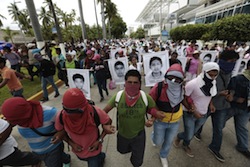Nearly four months after 43 students disappeared on their way to a protest in Mexico’s Guerrero state, details continue to emerge in a case that has become the focus of mass protests and international criticism.
According to testimony obtained by VICE, members of Guerreros Unidos, the criminal group that allegedly carried out the attacks, said they believed members of rival gang Los Rojos were among the students travelling to Iguala. If the statement is true, the movement of the students would have been perceived as an incursion into Guerreros Unidos territory.
While the students deny any affiliation with Los Rojos, the new information may provide insight into why they were targeted. Previous explanations have focused on the former mayor of Iguala and his wife, who have been identified as the intellectual authors of the attack. (For a full recap of the missing students case, click through InSight Crime’s timeline below).
In another development, on January 22, Amnesty International lambasted the Attorney General’s office (PGR), and said that more scrutiny should be placed on the army.
The human rights organization’s criticism came a day after a team of Austrian forensic scientists stated that they were unable to identify the DNA from remains gathered at a mass grave in Guerrero.
Insight Crime Analysis
With many Mexicans blaming the federal government for this tragedy, the Peña Nieto administration has scrambled to maintain credibility. Once heralded as an uncharacteristically open investigation — one autopsy was filmed and made publically available — recent information has repeatedly called the official story into question.
However, the testimony about Los Rojos may not be accurate either. A December 2014 investigation by the magazine Proceso indicated that witnesses who testified about the attack were tortured, undermining their versions of the events.
Proceso also revealed that federal police knew about the movement of the students as they left their college in Ayotzinapa, and even shot at them later that night.
SEE ALSO: Mexico News and Profiles
Still, the fate of the bodies is unknown. Forensic scientists from Mexican university UNAM recently announced that the students’ bodies could not have been burned at the trash dump in Cocula, the supposed site of the massacre, adding weight to speculation that they may have been incinerated at an army crematorium nearby.
The Mexican government maintains that federal police and the army were not involved. At a January 20 event at the Wilson Center in Washington DC, Ariel Moutsatsos, the Minister for Press and Public Affairs at Mexico’s US embassy, said that the investigation has been “impeccably articulated” and “is truthful, regardless of whether someone believes it or not.”

